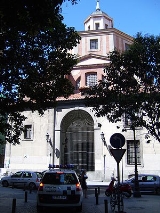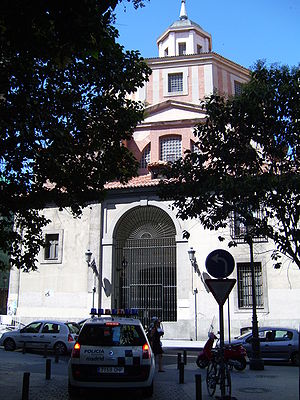
San Sebastian Church, Madrid
Encyclopedia
The Saint Sebastian Church or Iglesia de San Sebastián is a 16th century church in central Madrid
, Spain. It is located on Atocha street, #39. The name arises from a devotional chapel (ermita) which was found along the route to the Basilica of Nuestra Señora de Atocha
, founded in 1541. The first architect around 1550 was Antonio Sillero, who also finished the Chapel of the Sagrado Corazón. This church like that of San Luis conserved for years the rights of asylum for those escaping official persecution. More chapels and enlargements were added by Antonio de la Tijera, Juan de Bulga Valdelastras, and Juan de Obregón between 1595 and 1598. The tower was built in 1612 by Lucas Hernández.
During the Spanish Civil War
, the church was sacked by Republican forces, before it ended up being almost destroyed during a bombing raid by the Nationalists around November 20, 1936. This caused many of the works to be transferred to other sites. For example, the icon of San Blas
was moved to the convent of San Jerónimo el Real
). The church was rebuilt in a different orientation by Francisco Íñiguez Almech between 1943 and 1959. In 1969, it was declared a "Bien de Interés Cultural
" in the category of monument.
as director of the works, and remodeled by Ventura Rodríguez
in 1766-1768. Both Ventura Rodríguez and Juan de Villanueva
are buried here. The chapel is to the right of the entrance, protected by a crystal gate.
The Chapel of the Holy Heart was designed by Antonio Sillero.

is buried. It also was the site of the ghoulish incident after the burial of actress María Ignacia Ibáñez, when her lover, the writer José Cadalso
, lovelorn, attempted to dig up her body.
Madrid
Madrid is the capital and largest city of Spain. The population of the city is roughly 3.3 million and the entire population of the Madrid metropolitan area is calculated to be 6.271 million. It is the third largest city in the European Union, after London and Berlin, and its metropolitan...
, Spain. It is located on Atocha street, #39. The name arises from a devotional chapel (ermita) which was found along the route to the Basilica of Nuestra Señora de Atocha
Basilica of Nuestra Señora de Atocha
The Royal Basilica of Our Lady of Atocha or Real Basílica de Nuestra Señora de Atocha is a church in central Madrid on the avenue of the Ciudad de Barcelona, #3....
, founded in 1541. The first architect around 1550 was Antonio Sillero, who also finished the Chapel of the Sagrado Corazón. This church like that of San Luis conserved for years the rights of asylum for those escaping official persecution. More chapels and enlargements were added by Antonio de la Tijera, Juan de Bulga Valdelastras, and Juan de Obregón between 1595 and 1598. The tower was built in 1612 by Lucas Hernández.
During the Spanish Civil War
Spanish Civil War
The Spanish Civil WarAlso known as The Crusade among Nationalists, the Fourth Carlist War among Carlists, and The Rebellion or Uprising among Republicans. was a major conflict fought in Spain from 17 July 1936 to 1 April 1939...
, the church was sacked by Republican forces, before it ended up being almost destroyed during a bombing raid by the Nationalists around November 20, 1936. This caused many of the works to be transferred to other sites. For example, the icon of San Blas
Saint Blaise
Saint Blaise was a physician, and bishop of Sebastea . According to his Acta Sanctorum, he was martyred by being beaten, attacked with iron carding combs, and beheaded...
was moved to the convent of San Jerónimo el Real
San Jerónimo el Real
San Jerónimo el Real is a Roman Catholic church from the early 16th-century in central Madrid .The church, which has undergone numerous remodelings and restorations over the centuries is the remaining structure of the Hieronymite monastery that once stood beside the royal palace of Buen Retiro, of...
). The church was rebuilt in a different orientation by Francisco Íñiguez Almech between 1943 and 1959. In 1969, it was declared a "Bien de Interés Cultural
Bien de Interés Cultural
A Bien de Interés Cultural is a category of the Spanish heritage register. This category dates from 1985 when it replaced the former heritage category of Monumento nacional in order to extend protection to a wider range of cultural property...
" in the category of monument.
Chapels
The Chapel of Our Lady of Bethlehem, known as the "chapel of the architects", was built in 1693 with Francisco MorenoFrancisco Moreno
Francisco Pascacio Moreno was a prominent explorer and academic in Argentina, where he is usually referred to as Perito Moreno...
as director of the works, and remodeled by Ventura Rodríguez
Ventura Rodríguez
Ventura Rodríguez Tizón was a Spanish architect and artist. Born at Ciempozuelos, Rodríguez was the son of a bricklayer. In 1727, he collaborated with his father in the work at the Royal Palace of Aranjuez.-Major works:...
in 1766-1768. Both Ventura Rodríguez and Juan de Villanueva
Juan de Villanueva
Juan de Villanueva was a Spanish architect. Alongside Ventura Rodríguez, Villanueva is the best known architect of Spanish Neoclassicism....
are buried here. The chapel is to the right of the entrance, protected by a crystal gate.
The Chapel of the Holy Heart was designed by Antonio Sillero.
Historical importance
The archives of the church over the centuries have kept biographical data on numerous figures of renown, including:Baptism

- Ramón de la CruzRamón de la CruzRamón de la Cruz , Spanish neoclassical dramatist, was born in Madrid.He was a clerk in the ministry of finance, and is the author of three hundred sainetes, little farcical sketches of city life, written to be played between the acts of a longer play. He published a selection in ten volumes...
(1731) - Leandro Fernández de MoratínLeandro Fernández de MoratínLeandro Fernández de Moratín was a Spanish dramatist, translator and neoclassical poet.-Biography:Moratín was born in Madrid the son of Nicolás Fernández de Moratín, a major literary reformer in Spain from 1762 until his death in 1780.Distrusting the teaching offered in Spain's universities at...
(1760) - Patricio de la EscosuraPatricio de la EscosuraPatricio de la Escosura Morrogh was a Spanish politician, journalist, playwright and author associated with the Romantic school....
(1807) - Jerónimo María Usera y Alarcón (1810)
- Francisco Asenjo BarbieriFrancisco Asenjo BarbieriFrancisco Asenjo Barbieri was a well-known composer of the popular Spanish opera form, zarzuela. His works include: El barberillo de Lavapiés, Jugar con fuego, Pan y toros, Don Quijote, Los diamantes de la corona, and El Diablo en el poder.He was born and died in Madrid, appropriately, since the...
(1823) - Luis Madrazo Kuntz (1825)
- José de Echegaray (1832)
- Jacinto BenaventeJacinto BenaventeJacinto Benavente y Martínez was one of the foremost Spanish dramatists of the 20th century. He was awarded the Nobel Prize for Literature in 1922....
(1866)
Funeral services
- Miguel de CervantesMiguel de CervantesMiguel de Cervantes Saavedra was a Spanish novelist, poet, and playwright. His magnum opus, Don Quixote, considered the first modern novel, is a classic of Western literature, and is regarded amongst the best works of fiction ever written...
(1616) - Lope de VegaLope de VegaFélix Arturo Lope de Vega y Carpio was a Spanish playwright and poet. He was one of the key figures in the Spanish Golden Century Baroque literature...
(1635) - Juan Ruiz de AlarcónJuan Ruiz de AlarcónJuan Ruiz de Alarcón y Mendoza , one of the greatest Novohispanic dramatists of the Golden Age, was born in New Spain .-Genealogy:...
(1639) - Antonio de PeredaAntonio de PeredaAntonio de Pereda was a Spanish Baroque-era painter, best known for his still lifes. Pereda was born in Valladolid. He was the eldest of three brothers from an artistic family. His father, mother and two brothers were all painters. He was educated in Madrid by Pedro de las Cuevas and was taken...
(1678) - Ventura RodríguezVentura RodríguezVentura Rodríguez Tizón was a Spanish architect and artist. Born at Ciempozuelos, Rodríguez was the son of a bricklayer. In 1727, he collaborated with his father in the work at the Royal Palace of Aranjuez.-Major works:...
(1788) - Ramón de la CruzRamón de la CruzRamón de la Cruz , Spanish neoclassical dramatist, was born in Madrid.He was a clerk in the ministry of finance, and is the author of three hundred sainetes, little farcical sketches of city life, written to be played between the acts of a longer play. He published a selection in ten volumes...
(1794) - Nicolás del CampoNicolás del CampoNicolás Francisco Cristóbal del Campo, Marquis of Loreto was a Spanish politician and soldier who occupied several posts in the Spanish American colonies, mainly in the River Plate area.-Biography:...
(1803) - Juan de VillanuevaJuan de VillanuevaJuan de Villanueva was a Spanish architect. Alongside Ventura Rodríguez, Villanueva is the best known architect of Spanish Neoclassicism....
(1811) - José de EsproncedaJosé de EsproncedaJosé Ignacio Javier Oriol Encarnación de Espronceda y Delgado was a famous Romantic Spanish poet.-Life:Espronceda was born in Almendralejo, at the Province of Badajoz. As a youth, he studied at the Colegio San Mateo at Madrid, having as teacher Alberto Lista...
(1842)
Weddings
- Gustavo Adolfo BécquerGustavo Adolfo BécquerGustavo Adolfo Domínguez Bastida, better known as Gustavo Adolfo Bécquer, was a Spanish post-romanticist writer of poetry and short stories, now considered one of the most important figures in Spanish literature. He adopted the alias of Bécquer as his brother Valeriano Bécquer, a painter, had...
- Julián Romea
- Práxedes Mateo SagastaPráxedes Mateo SagastaPráxedes Mariano Mateo Sagasta y Escolar was a Spanish politician who served as Prime Minister on eight occasions between 1870 and 1902—always in charge of the Liberal Party—as part of the turno pacifico, alternating with the Liberal-Conservative leader Antonio Cánovas...
- Emilio Thuillier
- Mariano José de LarraMariano José de LarraMariano José de Larra was a Spanish romantic writer best known for his numerous essays, as well as his infamous suicide...
Cemetery
The cemetery, at the union of Huertas and San Sebastian streets, has disappeared and is now replaced by a flower shop. In this cemetery Lope de VegaLope de Vega
Félix Arturo Lope de Vega y Carpio was a Spanish playwright and poet. He was one of the key figures in the Spanish Golden Century Baroque literature...
is buried. It also was the site of the ghoulish incident after the burial of actress María Ignacia Ibáñez, when her lover, the writer José Cadalso
José Cadalso
José de Cadalso y Vázquez , Spanish, Colonel of the Royal Spanish Army, author, poet, playwright and essayist, one of the canonical producers of Spanish Enlightenment literature...
, lovelorn, attempted to dig up her body.

